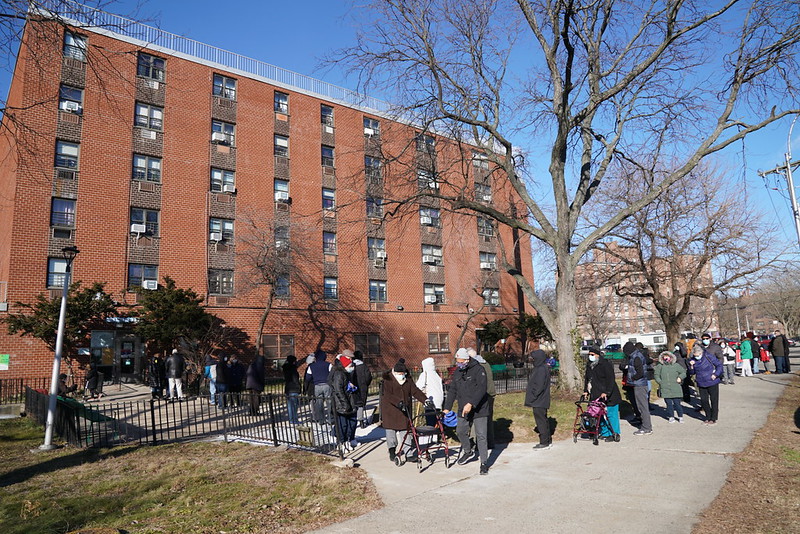
A housing line-up (photo: Governor's Office)
Governor Kathy Hochul’s commitment to a $25 billion, five-year housing plan creating and preserving 100,000 affordable homes throughout the state – including 10,000 supportive housing units designed to prevent homeessness – sends a bold and welcome signal to low-income New Yorkers still grappling with the spiraling economic effects of the pandemic.
At a time when 4 in 10 job losses have not come back since early 2020 – especially in food service, tourism, and retail sectors populated by hourly workers – we must tackle the complexities of creating more affordable and supportive housing. Otherwise, we’ll see a deepening of the bifurcated economy that has led to greater homelessness among families, curtails children’s long-term potential, and threatens the future vibrancy of our city.
Affordable and permanent supportive housing play vital roles in keeping people housed. Affordable housing enables low-income New Yorkers to pay a portion of their income for rent – 30% for applicants with income up to roughly $25,000 for an individual and up to $36,000 for a family of four – and be protected from dramatic hikes. Provided by entities like NYCHA and the New York City Department of Housing Preservation and Development, most affordable housing is accessed via lottery and requires a 12-month positive rental history. This can be a high bar for individuals and families in shelter or facing homelessness.
Supportive housing is a subset of affordable housing focused on many of the most vulnerable New Yorkers. In residences built for this purpose or through subsidized apartments, supportive housing offers the dignity of a lease and key at 30% of a person’s income – coupled with counseling to enable long-term security by addressing employment, health, special needs, or substance abuse barriers.
There are some 50,000 supportive housing units in New York – the leader in the nation. The state and city have each pledged 15,000 supportive housing units by 2030, and have funded approximately 40%. The NYC 15/15 Initiative has funded residences including ones we have built for veterans, LGBTQ+ young adults, and families. Yet the needs are far greater.
Last year, more than 107,000 different homeless individuals, including nearly 32,000 children, slept in the New York City Department of Homeless Services shelter system. More than half of all families in shelters have at least one member with a disability.
Lack of supportive housing is one of the primary drivers of homelessness – but its impact is felt across our neighbors’ education, employment, and health and wellness. Even as parents struggle to get or keep jobs, life in a shelter can lead to disruptions in their children’s access to healthy food, school transportation, and technology, and to increased risks of physical or mental health issues.
That’s why supportive housing, which includes vital social services, is essential to our city’s long-term housing plan. Among Jericho Project’s nine supportive housing residences, 95% of all residents do not return to homelessness.
But there are stubborn obstacles, such as New York’s deficit in supportive housing stock and a shortage of vacant land that helps keep prices stratospheric. Those developers committed to housing equity face a gauntlet of city, state, and, often, private funding requirements. And sadly, most supportive housing units require negotiations with community boards to accept them into neighborhoods.
Converting hotels into studio apartments can be another source of supportive housing, as outlined last September in a plan by now-Mayor Eric Adams to create 25,000 total housing units from such conversions. Recently, Governor Hochul said she wants to amend a state law to allow hotels within 800 feet of a residential area to be converted into permanent homes.
Another important tool is the 15% set-aside of residential units for formerly homeless individuals and families in affordable housing projects receiving public funds, implemented by New York City beginning in 2020.
For these to succeed, we as individuals can make a difference. Housing insecure families are like any of us. They want the best for their children, but struggle with issues that can push them into homelessness: disabilities among children or adults; a lost job; caregiver demands; mental health issues, a health setback.
We all share the same backyard when it comes to the future of our city. Let’s consider our choices:
Will we fear a hotel conversion or teach our children how to live alongside others not as fortunate as ourselves?
Will we refuse to rent where apartments are set aside for formerly homeless families, or value how they transform lives?
Will we remain a city of inequality, where hourly workers – who staffed the office buildings, hotels, and restaurants that brought our city wealth – cannot afford to live?
It will take the political will of our leaders – and a choice of conscience among New Yorkers – to shape a city we can be proud of post-pandemic.
***
Tori Lyon is CEO of Jericho Project, a 39-year-old nonprofit providing housing and services to nearly 3,000 homeless and housing insecure New Yorkers annually. On Twitter @JerichoProject1.
***
Have an op-ed idea or submission for Gotham Gazette? Email This email address is being protected from spambots. You need JavaScript enabled to view it.




